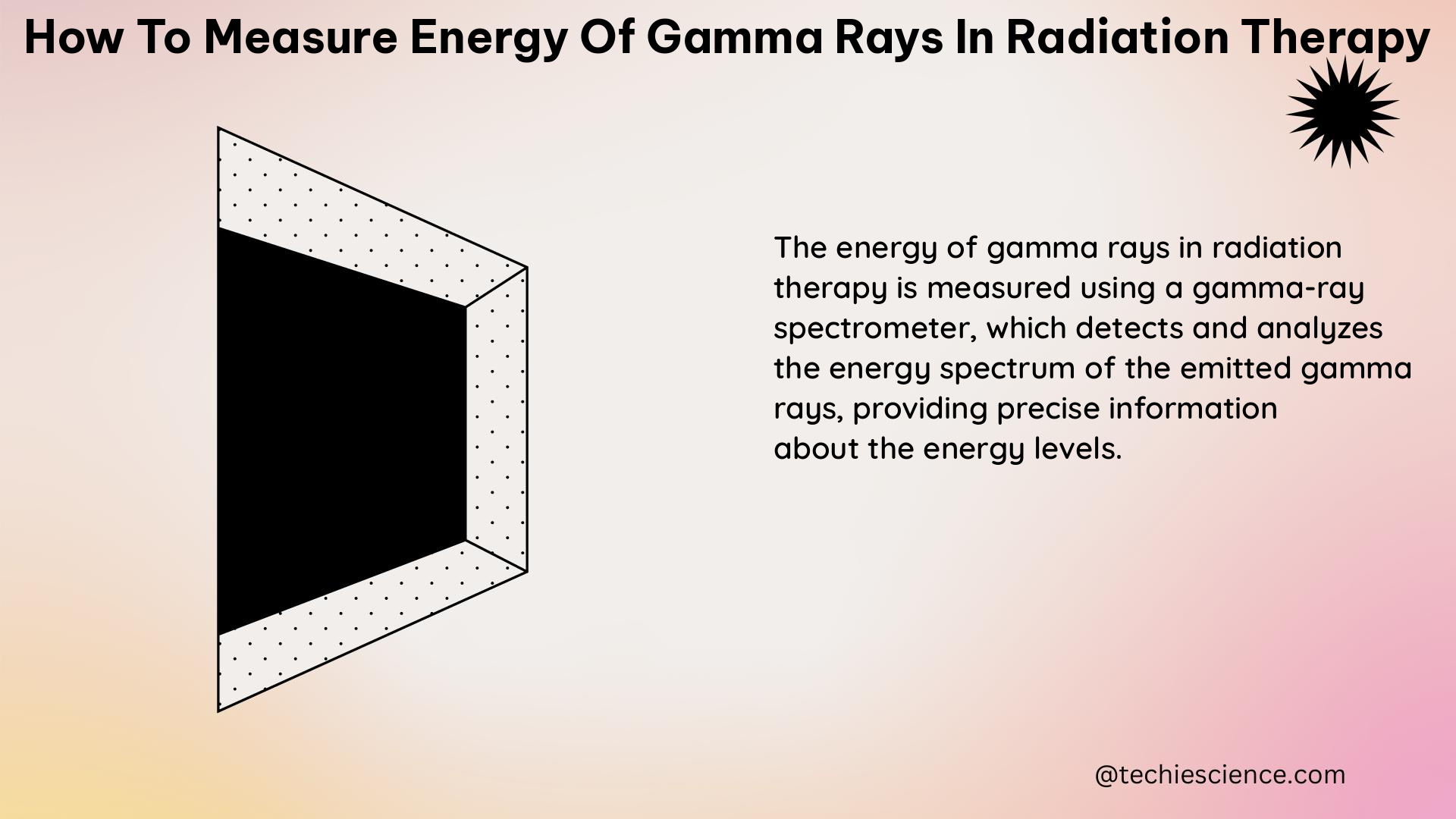Measuring the energy of gamma rays in radiation therapy is a crucial step in understanding the penetration depth, dose distribution, and overall effectiveness of the treatment. This comprehensive guide will delve into the various methods and techniques employed to accurately determine the energy of gamma rays, providing physics students with a detailed, hands-on understanding of the process.
High-Resolution Gamma-Ray Spectrometry
One of the primary methods used to measure the energy of gamma rays in radiation therapy is High-Resolution Gamma-Ray Spectrometry. This technique utilizes the Photoelectric Effect, where the full energy of the original gamma ray is measured through the interaction.
Photoelectric Effect
The Photoelectric Effect is a fundamental interaction between gamma rays and matter, where a gamma ray photon is absorbed by an atom, and an electron is ejected from the atom’s inner shell. The energy of the ejected electron is equal to the energy of the gamma ray photon minus the binding energy of the electron in the atom.
The Photoelectric Effect is the dominant interaction for gamma rays with energies below 0.5 MeV, making it a crucial process in the measurement of gamma ray energy in radiation therapy.
Gamma-Ray Spectrometry
Gamma-ray spectrometry is used in the context of radiation therapy to identify and quantify gamma-ray emitting radionuclides. This process involves the following steps:
-
Spectrum Processing: The acquired gamma-ray spectrum is processed to extract relevant information, such as the energy and intensity of the observed gamma-ray peaks.
-
Radioactive Decay Mode Understanding: The radioactive decay modes of the radionuclides present in the sample are understood to interpret the observed gamma-ray peaks correctly.
-
Gamma-Ray Identification: The observed gamma-ray peaks are identified based on their energies and the potential threat radionuclides that may be present.
Gamma-Ray Spectrometer
A gamma-ray spectrometer typically uses large-volume NaI detectors, which have energy resolutions of 10% for 137Cs at 0.662 MeV and 7% for 208Tl at 2.61 MeV. The spectrometer energy resolution is defined as the full width of a photopeak at half the maximum amplitude (FWHM) expressed as a percentage.
The energy resolution of the spectrometer is crucial in determining the accuracy and precision of the gamma-ray energy measurements. A higher energy resolution allows for better separation and identification of individual gamma-ray peaks, leading to more accurate energy determinations.
Spectral Window Monitoring

The conventional approach to acquiring and processing gamma-ray spectrometric data involves monitoring three or four relatively broad spectral windows:
-
K Energy Window: This window is used to monitor the activity of 40K, a naturally occurring radioactive isotope.
-
U and Th Energy Windows: These windows are used to monitor the decay products in the uranium (U) and thorium (Th) decay series.
-
Total-Count Window: This window is used to monitor the total radioactivity in the sample.
By monitoring these specific spectral windows, the gamma-ray emissions can be quantified and used to determine the energy of the gamma rays in the radiation therapy context.
Gamma-Ray Energy Units
The energy of gamma rays in radiation therapy is typically expressed in the following units:
- Electron Volts (eV): This is the fundamental unit of energy, where 1 eV is the energy gained by an electron when it is accelerated through a potential difference of 1 volt.
- Kiloelectron Volts (keV): This is a larger unit of energy, where 1 keV = 1,000 eV.
- Megaelectron Volts (MeV): This is an even larger unit of energy, where 1 MeV = 1,000,000 eV.
The choice of unit depends on the energy range of the gamma rays being measured, with lower-energy gamma rays typically measured in keV and higher-energy gamma rays measured in MeV.
Practical Examples and Numerical Problems
To further illustrate the concepts of measuring gamma-ray energy in radiation therapy, let’s consider the following examples and numerical problems:
Example 1: Measuring the Energy of 137Cs Gamma Rays
– 137Cs is a common radionuclide used in radiation therapy, emitting gamma rays with an energy of 0.662 MeV.
– Using a gamma-ray spectrometer with a NaI detector, the energy resolution is measured to be 10% at 0.662 MeV.
– Calculate the full width at half maximum (FWHM) of the 137Cs photopeak.
Solution:
FWHM = 10% of 0.662 MeV = 0.0662 MeV
Example 2: Determining the Penetration Depth of Gamma Rays
– A patient is receiving radiation therapy with a gamma-ray source emitting at an energy of 1.25 MeV.
– The patient’s tissue has an average density of 1.05 g/cm³.
– Calculate the approximate penetration depth of the 1.25 MeV gamma rays in the patient’s tissue, assuming a linear attenuation coefficient of 0.0533 cm²/g.
Solution:
Penetration depth = 1 / (linear attenuation coefficient × tissue density)
Penetration depth = 1 / (0.0533 cm²/g × 1.05 g/cm³) = 17.8 cm
These examples demonstrate the practical application of gamma-ray energy measurement in the context of radiation therapy, highlighting the importance of accurate energy determination for effective treatment planning and delivery.
Conclusion
Measuring the energy of gamma rays in radiation therapy is a crucial step in understanding the behavior and effectiveness of the treatment. By employing high-resolution gamma-ray spectrometry, monitoring specific spectral windows, and understanding the relevant units and physical principles, physics students can develop a comprehensive understanding of this essential process in radiation therapy.
References
- Gamma-Ray Spectrometry Techniques for Environmental Monitoring
- Measurement of Radioactivity
- Guide for High Resolution Gamma Spectrometry Analyses
- Measurement of Radioactivity in the Environment
- The Units to Measure Radiation Explained

The lambdageeks.com Core SME Team is a group of experienced subject matter experts from diverse scientific and technical fields including Physics, Chemistry, Technology,Electronics & Electrical Engineering, Automotive, Mechanical Engineering. Our team collaborates to create high-quality, well-researched articles on a wide range of science and technology topics for the lambdageeks.com website.
All Our Senior SME are having more than 7 Years of experience in the respective fields . They are either Working Industry Professionals or assocaited With different Universities. Refer Our Authors Page to get to know About our Core SMEs.